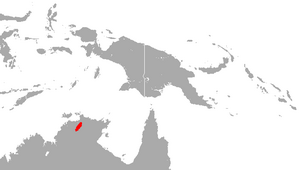Arnhem leaf-nosed bat facts for kids
Quick facts for kids Arnhem leaf-nosed bat |
|
|---|---|
| Conservation status | |
| Scientific classification | |
| Genus: |
Hipposideros
|
| Species: |
inornatus
|
 |
|
| Range of H. inornatus in northern Australia | |
| Synonyms | |
|
|
The Arnhem leaf-nosed bat (Hipposideros inornatus) is a type of bat. It belongs to the family Hipposideridae. This special bat lives in the rocky, sandstone areas of Kakadu National Park in the Northern Territory, Australia.
Contents
About the Arnhem Leaf-Nosed Bat's Name
Scientists first described this bat in 1970. At first, they thought it was a subspecies, which is like a smaller group, of another bat called the diadem leaf-nosed bat.
Over the years, its classification has changed many times. Sometimes it was seen as a full species. Other times, it was considered a subspecies. Now, scientists agree it is its own full species.
The bat's scientific name, "inornatus", comes from Latin. It means "unadorned" or "plain." This might refer to its appearance.
Life and Habits of the Bat
The Arnhem leaf-nosed bat is a nocturnal animal. This means it is active at night. During the day, it rests and sleeps in safe, sheltered places. These places are often caves or old, unused mines.
This bat is an insectivore. This means it eats insects. Its diet includes many different bugs. It enjoys eating beetles, moths, cockroaches, and leafhoppers.
Where the Bat Lives
This bat is endemic to the Northern Territory of Australia. This means it is found only in this specific area.
Most recent sightings of the Arnhem leaf-nosed bat have been inside Kakadu National Park. This park is a very important place for these bats to live safely.
Protecting the Arnhem Leaf-Nosed Bat
As of 2020, the IUCN lists this bat as a vulnerable species. This means it is at risk of becoming endangered.
The main reason for this classification is that there are fewer than 1,000 adult bats left. Even though their numbers are low, scientists believe the population is stable. This means it is not getting smaller very quickly.
The bat lives in a protected area, Kakadu National Park. This helps keep them safe. In Australia, the government lists it as "endangered" under the EPBC Act. The Northern Territory also lists it as "vulnerable" under their own law, the Territory Parks and Wildlife Conservation Act 2000. These laws help protect the bat and its home.


